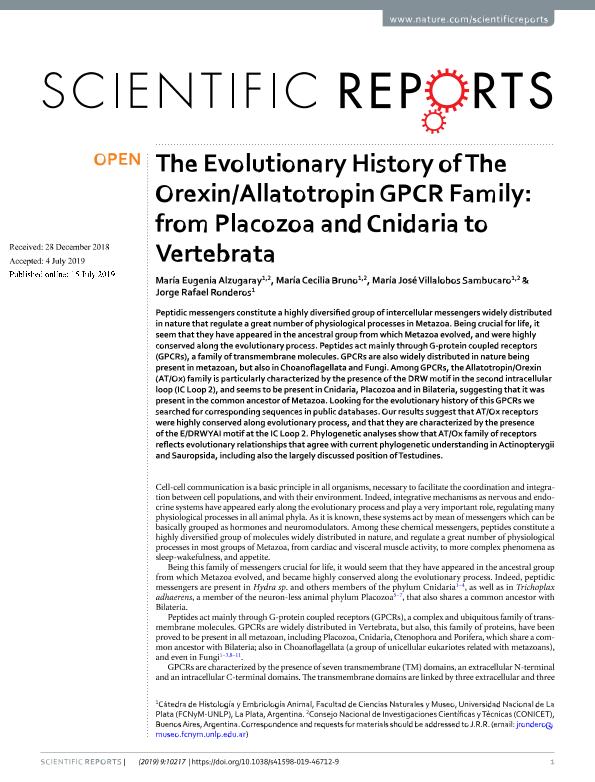Mostrar el registro sencillo del ítem
dc.contributor.author
Alzugaray, Maria Eugenia

dc.contributor.author
Bruno, María Cecilia

dc.contributor.author
Villalobos Sambucaro, María José

dc.contributor.author
Ronderos, Jorge Rafael

dc.date.available
2020-04-22T20:12:44Z
dc.date.issued
2019-07
dc.identifier.citation
Alzugaray, Maria Eugenia; Bruno, María Cecilia; Villalobos Sambucaro, María José; Ronderos, Jorge Rafael; The Evolutionary History of The Orexin/Allatotropin GPCR Family: From Placozoa and Cnidaria to Vertebrata; Nature Research; Scientific Reports; 9; 7-2019; 1-11
dc.identifier.issn
2045-2322
dc.identifier.uri
http://hdl.handle.net/11336/103354
dc.description.abstract
Peptidic messengers constitute a highly diversified group of intercellular messengers widely distributedin nature that regulate a great number of physiological processes in Metazoa. Being crucial for life, itseem that they have appeared in the ancestral group from which Metazoa evolved, and were highlyconserved along the evolutionary process. Peptides act mainly through G-protein coupled receptors(GPCRs), a family of transmembrane molecules. GPCRs are also widely distributed in nature beingpresent in metazoan, but also in Choanoflagellata and Fungi. Among GPCRs, the Allatotropin/Orexin(AT/Ox) family is particularly characterized by the presence of the DRW motif in the second intracellularloop (IC Loop 2), and seems to be present in Cnidaria, Placozoa and in Bilateria, suggesting that it waspresent in the common ancestor of Metazoa. Looking for the evolutionary history of this GPCRs wesearched for corresponding sequences in public databases. Our results suggest that AT/Ox receptorswere highly conserved along evolutionary process, and that they are characterized by the presenceof the E/DRWYAI motif at the IC Loop 2. Phylogenetic analyses show that AT/Ox family of receptorsreflects evolutionary relationships that agree with current phylogenetic understanding in Actinopterygiiand Sauropsida, including also the largely discussed position of Testudines
dc.format
application/pdf
dc.language.iso
eng
dc.publisher
Nature Research
dc.rights
info:eu-repo/semantics/openAccess
dc.rights.uri
https://creativecommons.org/licenses/by/2.5/ar/
dc.subject
Allatotropin
dc.subject
Orexin
dc.subject
Evolution
dc.subject
GPCR
dc.subject.classification
Biología

dc.subject.classification
Ciencias Biológicas

dc.subject.classification
CIENCIAS NATURALES Y EXACTAS

dc.title
The Evolutionary History of The Orexin/Allatotropin GPCR Family: From Placozoa and Cnidaria to Vertebrata
dc.type
info:eu-repo/semantics/article
dc.type
info:ar-repo/semantics/artículo
dc.type
info:eu-repo/semantics/publishedVersion
dc.date.updated
2020-04-22T15:29:22Z
dc.journal.volume
9
dc.journal.pagination
1-11
dc.journal.pais
Reino Unido

dc.description.fil
Fil: Alzugaray, Maria Eugenia. Universidad Nacional de La Plata. Facultad de Ciencias Naturales y Museo. Cátedra de Histología y Embriología Animal; Argentina. Consejo Nacional de Investigaciones Científicas y Técnicas. Centro Científico Tecnológico Conicet - La Plata; Argentina
dc.description.fil
Fil: Bruno, María Cecilia. Consejo Nacional de Investigaciones Científicas y Técnicas. Centro Científico Tecnológico Conicet - La Plata; Argentina. Universidad Nacional de La Plata. Facultad de Ciencias Naturales y Museo. Cátedra de Histología y Embriología Animal; Argentina
dc.description.fil
Fil: Villalobos Sambucaro, María José. Universidad Nacional de La Plata. Facultad de Ciencias Naturales y Museo. Cátedra de Histología y Embriología Animal; Argentina. Consejo Nacional de Investigaciones Científicas y Técnicas. Centro Científico Tecnológico Conicet - La Plata; Argentina
dc.description.fil
Fil: Ronderos, Jorge Rafael. Universidad Nacional de La Plata. Facultad de Ciencias Naturales y Museo. Cátedra de Histología y Embriología Animal; Argentina
dc.journal.title
Scientific Reports
dc.relation.alternativeid
info:eu-repo/semantics/altIdentifier/url/https://www.nature.com/articles/s41598-019-46712-9
dc.relation.alternativeid
info:eu-repo/semantics/altIdentifier/doi/http://dx.doi.org/10.1038/s41598-019-46712-9
Archivos asociados
